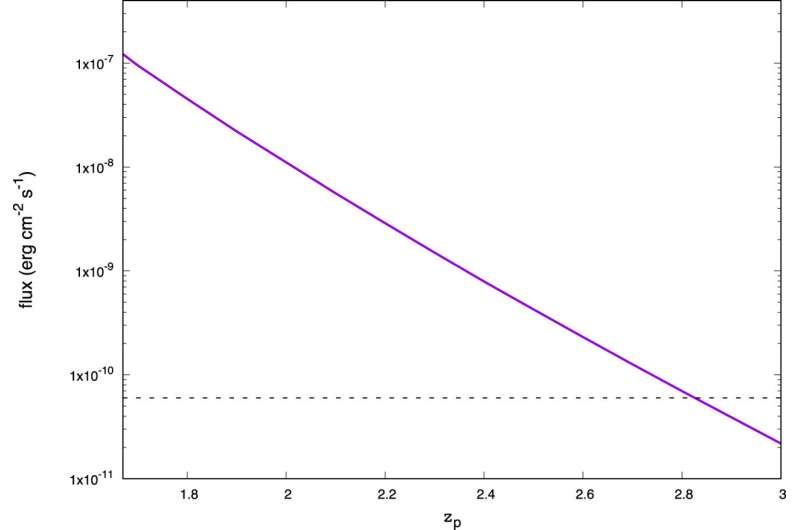The jitter radiation flux as a function of the spectral index ζp of the turbulence. The solid line (purple) indicates the calculation result with the parameters of γ = 1.0 × 107 and A = 3.0 × 10−5 cm−3. The dashed line (gray) is the LHAASO sensitivity (2000 s) at 18 TeV. Credit: The Astrophysical Journal (2023). DOI: 10.3847/1538-4357/acc400
A gamma-ray burst is the most violent explosion in the universe. The research on gamma-ray bursts, including a central engine, magnetized dynamics of plasmas, and radiation, is one of the hot topics in the high-energy astrophysical research.
The so-called "brightest of all time" gamma-ray burst, GRB 221009A, has been detected by satellites and ground-based telescopes. The burst has a strong emission in the TeV energy band.
Researchers led by Profs. Mao Jirong and Wang Jiancheng from the Yunnan Observatories (YNAO) of the Chinese Academy of Sciences (CAS) have explored the radiation mechanism of GRB 221009A. Their findings were published in The Astrophysical Journal on April 4.
The researchers proposed a novel radiation mechanism, i.e., the radiation of the relativistic electrons in the random and small-scale magnetic field. They applied this mechanism to explain the very high energy emission of GRB 221009A. In particular, for this mechanism, they utilized the Landau damping, a plasma effect, to constrain the emission of GRB 221009A in the TeV energy band.
Furthermore, they treated the mechanism as a kind of coherent radiation to reproduce the emission flux of GRB 221009A. Thus, the observation properties of the burst are theoretically interpreted by this radiation mechanism.
More information: Jirong Mao et al, Jitter Mechanism as a Kind of Coherent Radiation: Constrained by the GRB 221009A Emission at 18 TeV, The Astrophysical Journal (2023). DOI: 10.3847/1538-4357/acc400
Journal information: Astrophysical Journal
Provided by Chinese Academy of Sciences
























